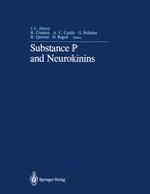1987 | OriginalPaper | Buchkapitel
Heterogeneity of Central and Peripheral Tachykinin Binding Sites
verfasst von : P. W. Mantyh, C. R. Mantyh, J. E. Maggio
Erschienen in: Substance P and Neurokinins
Verlag: Springer New York
Enthalten in: Professional Book Archive
Aktivieren Sie unsere intelligente Suche, um passende Fachinhalte oder Patente zu finden.
Wählen Sie Textabschnitte aus um mit Künstlicher Intelligenz passenden Patente zu finden. powered by
Markieren Sie Textabschnitte, um KI-gestützt weitere passende Inhalte zu finden. powered by
The tachykinln family of small bioactive peptides are defined by their similar biological activities and conserved carboxyl-terminal sequence -Phe-X-Gly-Leu-Met-NH2, where X is an aromatic or branched al iphatic amino acid [1].The amino-termini of the tachykinins shows a much wider variation, and most of the biological activities of this peptide family reside in their similar carboxyl sequences. Substance P (X=Phe) is the most widely known member of the tachykinin family, and was for many years generally believed to be the only mammalian tachykinin. In recent years the discovery [2–4] of the novel mammalian tachykinins substance K and neuromedin K (both X=Val) has shown that mammalian tachykinin systems are more elaborate than previously supposed [9]. The new tachykinins differ from substance Pin their central and peripheral pharmacologies, mediating. different physio1ogica1 funct ions through different receptors. In the present report we have used several different radiolabeled tachyki ni ns to invest i gate the distribution and heterogeneity of tachyki ni n bi ndi ng sites in the rat brain and periphery and the canine gastrointestinal system.
